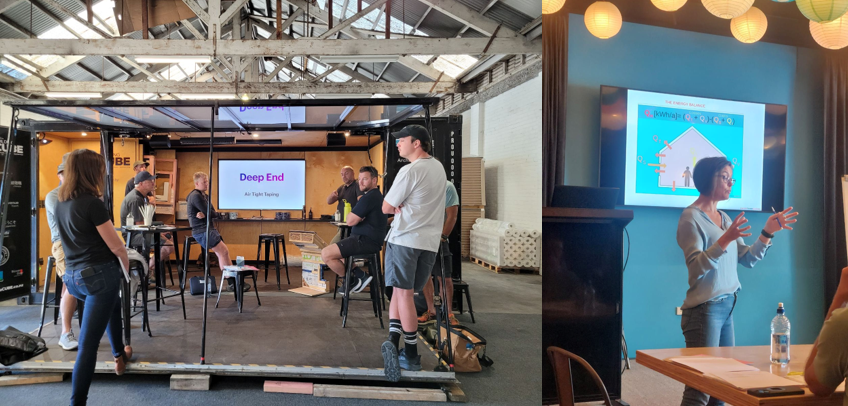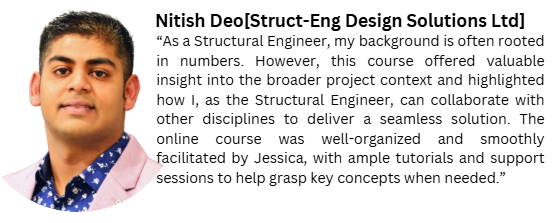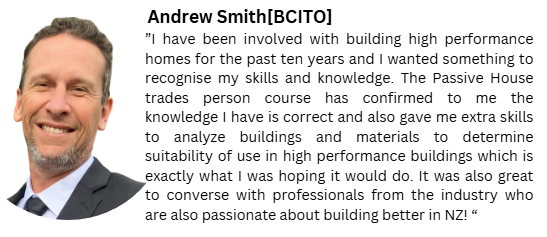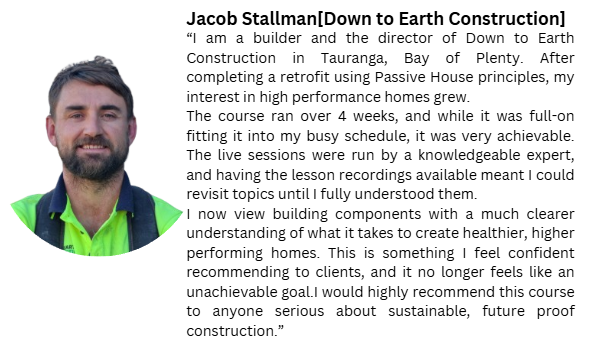
This course teaches key skills and knowledge required to confidently and efficiently build high-performance structures. Passive House requires novel construction details and methods not found in Code-minimum buildings. The quality of construction is crucial to obtaining Passive House certification. Passing the exam entitles the student to call him or herself a certified Passive House tradesperson, a badge of competence to proudly display in the marketplace.
This online version provides an alternative pathway to achieving Passive House Tradesperson certification. Eight live two-hour sessions start at 7.30am, allowing attendees to promptly get back on the tools.
Sustainable Engineering Ltd will continue to offer the course in person (the next is in Auckland, 20-24 October 2025), mixing theory and practical. We provide different pathways so that builders and other tradies can choose the option that best suits them and their employees.
In Their Own Words
Recommended resources and knowledge
This course is designed for New Zealand tradespeople. In order to fully benefit from this learning opportunity, students needs to be motivated and enthusiastic, to have understanding and experience of New Zealand construction systems and proficiency in mathematics to senior secondary school level.
Detailed course outcomes
The course is designed to prepare qualified students for the PHI Certified Passive House Tradesperson exam. Understand the theory and practical application of:
- building science
- how heat and moisture move through building assemblies
- the overall Passive House concept
- thermal envelopes
- the three construction layers
- high-performance windows and doors
- airtightness
- ventilation
- thermal bridging
- building services for high-performance buildings
- shading and overheating
Dates & location
2hr sessions twice a week on Tuesday and Thursdays. 8am to 10am is scheduled to run on 21 April 2026 – 12 May 2026
Investment
$1880 (excl GST) early bird price. An additional 10% discount for PHINZ members.
Limitations, liability and copyright
There will be no refunds once the course has been accessed so it is important that students understand the prerequisites and what is expected of them. This course involves mathematics and physics (high school level); this will not be taught in class.
The course materials such as handouts represent a significant investment in intellectual property. They are copyright and provided for your own use. They may not be published, copied or distributed.
The authors of the information in this course have used their best efforts to provide accurate and authoritative information in regard to the subject matter covered. While reasonable care has been taken to provide accurate information, the author(s) and Sustainable Engineering Ltd make no warranty of any kind, expressed or implied, with regard to the information provided being suitable for any particular purpose. The information presented must be used with care by professionals who understand the implications of what they are doing. The author(s) and Sustainable Engineering Ltd shall not be liable in the event of incidental or consequential damages in connection with, or arising from, the use of the information contained in this course.


